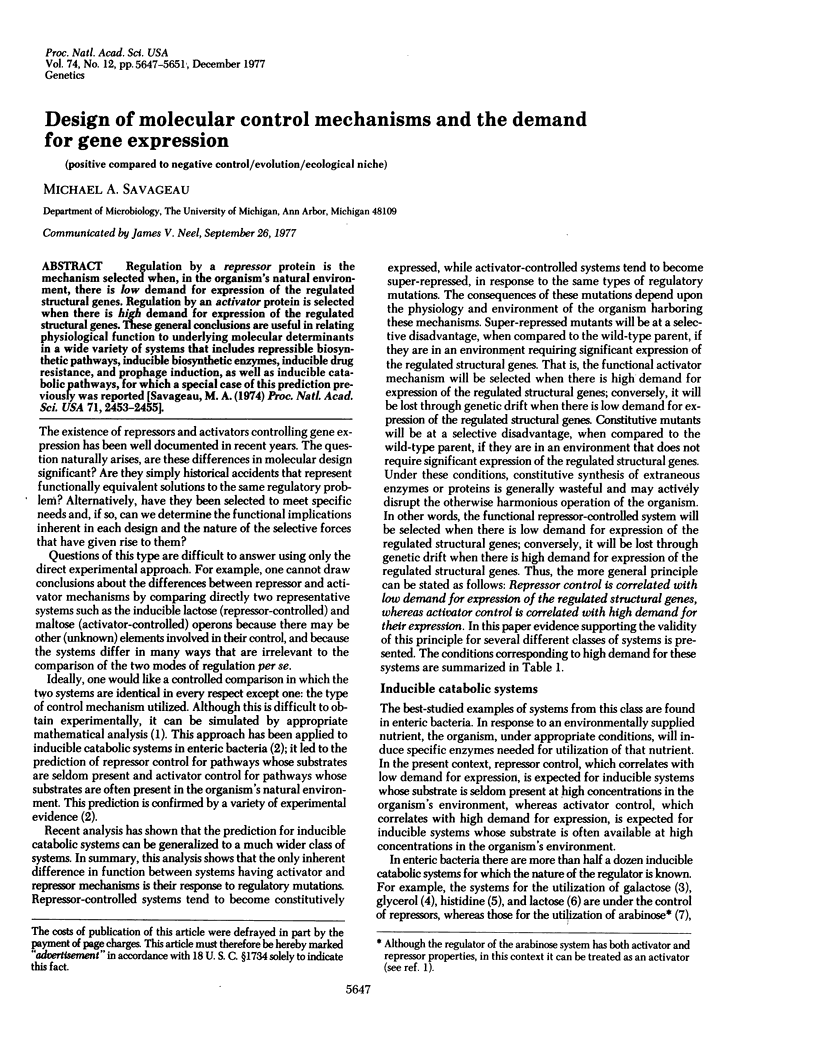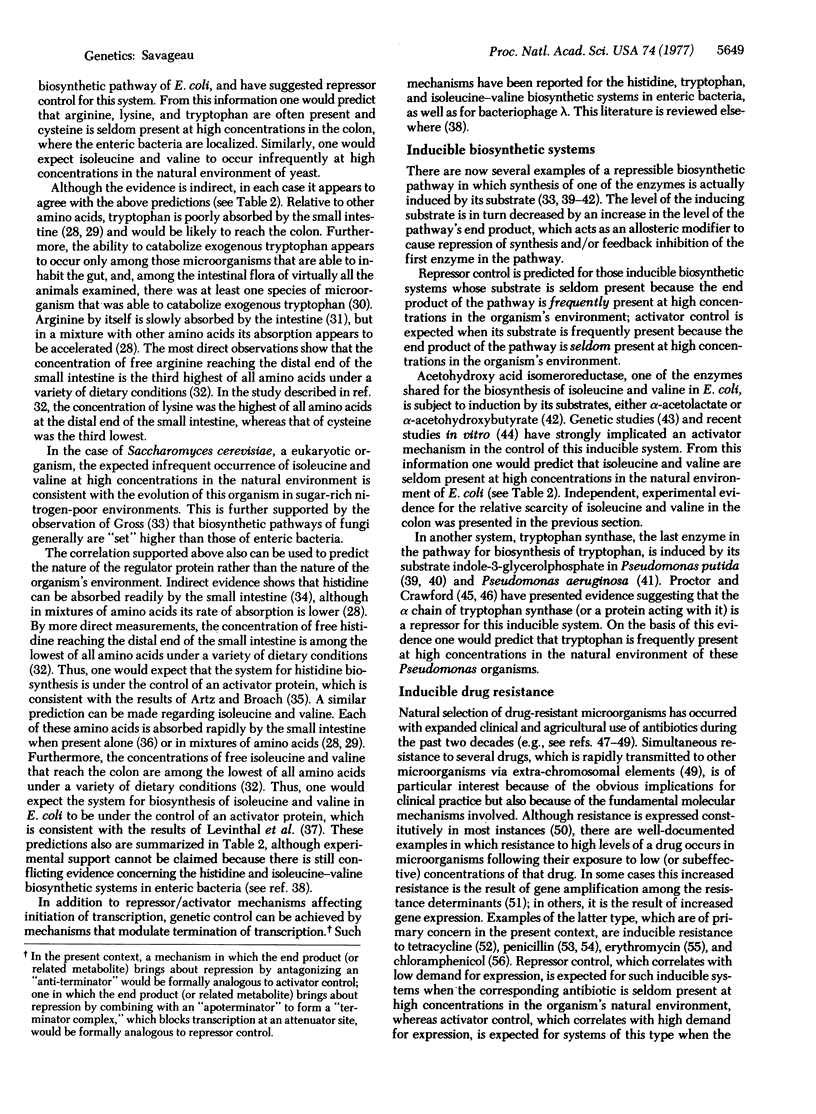Abstract
Regulation by a repressor protein is the mechanism selected when, in the organism's natural environment, there is low demand for expression of the regulated structural genes. Regulation by an activator protein is selected when there is high demand for expression of the regulated structural genes. These general conclusions are useful in relating physiological function to underlying molecular determinants in a wide variety of systems that includes repressible biosynthetic pathways, inducible biosynthetic enzymes, inducible drug resistance, and prophage induction, as well as inducible catabolic pathways, for which a special case of this prediction previously was reported [Savageau, M. A. (1974) Proc. Natl. Acad. Sci. USA 71, 2453-2455].
Full text
PDF




Selected References
These references are in PubMed. This may not be the complete list of references from this article.
- Adibi S. A., Gray S. J. Intestinal absorption of essential amino acids in man. Gastroenterology. 1967 May;52(5):837–845. [PubMed] [Google Scholar]
- Adibi S. A., Gray S. J., Menden E. The kinetics of amino acid absorption and alteration of plasma composition of free amino acids after intestinal perfusion of amino acid mixtures. Am J Clin Nutr. 1967 Jan;20(1):24–33. doi: 10.1093/ajcn/20.1.24. [DOI] [PubMed] [Google Scholar]
- Anderson E. S. The ecology of transferable drug resistance in the enterobacteria. Annu Rev Microbiol. 1968;22:131–180. doi: 10.1146/annurev.mi.22.100168.001023. [DOI] [PubMed] [Google Scholar]
- Artz S. W., Broach J. R. Histidine regulation in Salmonella typhimurium: an activator attenuator model of gene regulation. Proc Natl Acad Sci U S A. 1975 Sep;72(9):3453–3457. doi: 10.1073/pnas.72.9.3453. [DOI] [PMC free article] [PubMed] [Google Scholar]
- Barksdale L., Arden S. B. Persisting bacteriophage infections, lysogeny, and phage conversions. Annu Rev Microbiol. 1974;28(0):265–299. doi: 10.1146/annurev.mi.28.100174.001405. [DOI] [PubMed] [Google Scholar]
- Bernhard H. P. The control of gene expression in somatic cell hybrids. Int Rev Cytol. 1976;47:289–325. doi: 10.1016/s0074-7696(08)60091-1. [DOI] [PubMed] [Google Scholar]
- Bertani L. E., Bertani G. Genetics of P2 and related phages. Adv Genet. 1971;16:199–237. doi: 10.1016/s0065-2660(08)60359-4. [DOI] [PubMed] [Google Scholar]
- Bihler I. Intestinal sugar transport: ionic activation and chemical specificity. Biochim Biophys Acta. 1969 Jun 3;183(1):169–181. doi: 10.1016/0005-2736(69)90141-2. [DOI] [PubMed] [Google Scholar]
- Bollon A. P. Fine structure analysis of a eukaryotic multifunctional gene. Nature. 1974 Aug 23;250(5468):630–634. doi: 10.1038/250630a0. [DOI] [PubMed] [Google Scholar]
- Bollon A. P., Magee P. T. Involvement of threonine deaminase in multivalent repression of the isoleucine-valine pathway in Saccharomyces cerevisiae. Proc Natl Acad Sci U S A. 1971 Sep;68(9):2169–2172. doi: 10.1073/pnas.68.9.2169. [DOI] [PMC free article] [PubMed] [Google Scholar]
- Bollon A. P., Magee P. T. Involvement of threonine deaminase in repression of the isoleucine-valine and leucine pathways in Saccharomyces cerevisiae. J Bacteriol. 1973 Mar;113(3):1333–1344. doi: 10.1128/jb.113.3.1333-1344.1973. [DOI] [PMC free article] [PubMed] [Google Scholar]
- Bollon A. P. Regulation of the ilv 1 multifunctional gene in Saccharomyces cerevisiae. Mol Gen Genet. 1975 Dec 23;142(1):1–12. doi: 10.1007/BF00268750. [DOI] [PubMed] [Google Scholar]
- Calhoun D. H., Pierson D. L., Jensen R. A. The regulation of tryptophan biosynthesis in Pseudomonas aeruginosa. Mol Gen Genet. 1973 Mar 1;121(2):117–132. doi: 10.1007/BF00277526. [DOI] [PubMed] [Google Scholar]
- Cozzarelli N. R., Freedberg W. B., Lin E. C. Genetic control of L-alpha-glycerophosphate system in Escherichia coli. J Mol Biol. 1968 Feb 14;31(3):371–387. doi: 10.1016/0022-2836(68)90415-4. [DOI] [PubMed] [Google Scholar]
- Crawford I. P., Gunsalus I. C. Inducibility of tryptophan synthetase in Pseudomonas putida. Proc Natl Acad Sci U S A. 1966 Aug;56(2):717–724. doi: 10.1073/pnas.56.2.717. [DOI] [PMC free article] [PubMed] [Google Scholar]
- Cunin R., Kelker N., Boyen A., Yang H., Zubay G., Glansdorff N., Maas W. K. Involvement of arginine in in vitro repression of transcription of arginine genes C, B and H in Escherichia coli K 12. Biochem Biophys Res Commun. 1976 Mar 22;69(2):377–382. doi: 10.1016/0006-291x(76)90532-5. [DOI] [PubMed] [Google Scholar]
- DAVIS B. D. The teleonomic significance of biosynthetic control mechanisms. Cold Spring Harb Symp Quant Biol. 1961;26:1–10. doi: 10.1101/sqb.1961.026.01.005. [DOI] [PubMed] [Google Scholar]
- Davidson R. L. Gene expression in somatic cell hybrids. Annu Rev Genet. 1974;8:195–218. doi: 10.1146/annurev.ge.08.120174.001211. [DOI] [PubMed] [Google Scholar]
- Davies J. E., Rownd R. Transmissible multiple drug resistance in Enterobacteriaceae. Science. 1972 May 19;176(4036):758–768. doi: 10.1126/science.176.4036.758. [DOI] [PubMed] [Google Scholar]
- Davis F. M., Adelberg E. A. Use of somatic cell hybrids for analysis of the differentiated state. Bacteriol Rev. 1973 Jun;37(2):197–214. doi: 10.1128/br.37.2.197-214.1973. [DOI] [PMC free article] [PubMed] [Google Scholar]
- DeMoss R. D., Moser K. Tryptophanase in diverse bacterial species. J Bacteriol. 1969 Apr;98(1):167–171. doi: 10.1128/jb.98.1.167-171.1969. [DOI] [PMC free article] [PubMed] [Google Scholar]
- Echols H. Developmental pathways for the temperate phage: lysis vs lysogeny,. Annu Rev Genet. 1972;6(0):157–190. doi: 10.1146/annurev.ge.06.120172.001105. [DOI] [PubMed] [Google Scholar]
- FINCH L. R., HIRD F. J. The uptake of amino acids by isolated segments of rat intestine. II. A survey of affinity for uptake from rates of uptake and competition for uptake. Biochim Biophys Acta. 1960 Sep 23;43:278–287. doi: 10.1016/0006-3002(60)90438-8. [DOI] [PubMed] [Google Scholar]
- GIBSON Q. H., WISEMAN G. Selective absorption of stereo-isomers of amino-acids from loops of the small intestine of the rat. Biochem J. 1951 Apr;48(4):426–429. doi: 10.1042/bj0480426. [DOI] [PMC free article] [PubMed] [Google Scholar]
- Hofnung M., Schwartz M. Mutations allowing growth on maltose of Escherichia coli K 12 strains with a deleted malT gene. Mol Gen Genet. 1971;112(2):117–132. doi: 10.1007/BF00267490. [DOI] [PubMed] [Google Scholar]
- Imsande J., Lilleholm J. L. Characterization of mutations in the penicillinase operon Staphylococcus aureus. Mol Gen Genet. 1976 Aug 10;147(1):23–27. doi: 10.1007/BF00337931. [DOI] [PubMed] [Google Scholar]
- Jones-Mortimer M. C. Positive control of sulphate reduction in Escherichia coli. The nature of the pleiotropic cysteineless mutants of E. coli K12. Biochem J. 1968 Dec;110(3):597–602. doi: 10.1042/bj1100597. [DOI] [PMC free article] [PubMed] [Google Scholar]
- Kelleher R. J., Jr, Heggeness M. Repression of diaminopimelic acid decarboxylase in Escherichia coli: gene dosage effects and escape synthesis. J Bacteriol. 1976 Jan;125(1):376–378. doi: 10.1128/jb.125.1.376-378.1976. [DOI] [PMC free article] [PubMed] [Google Scholar]
- Kelly L. E., Brammar W. J. A frameshift mutation that elongates the penicillinase protein of Bacillus licheniformis. J Mol Biol. 1973 Oct 15;80(1):135–147. doi: 10.1016/0022-2836(73)90237-4. [DOI] [PubMed] [Google Scholar]
- Kredich N. M. Regulation of L-cysteine biosynthesis in Salmonella typhimurium. I. Effects of growth of varying sulfur sources and O-acetyl-L-serine on gene expression. J Biol Chem. 1971 Jun 10;246(11):3474–3484. [PubMed] [Google Scholar]
- Levine M. Replication and lysogeny with phage P22 in Salmonella typhimurium. Curr Top Microbiol Immunol. 1972;58:135–156. doi: 10.1007/978-3-642-65357-5_4. [DOI] [PubMed] [Google Scholar]
- Levinthal M., Williams L. S., Umbarger H. E. Role of threonine deaminase in the regulation of isoleucine and valine biosynthesis. Nat New Biol. 1973 Nov 21;246(151):65–68. doi: 10.1038/newbio246065a0. [DOI] [PubMed] [Google Scholar]
- Maurer R., Crawford I. P. New regulatory mutation affecting some of the tryptophan genes in Pseudomonas putida. J Bacteriol. 1971 May;106(2):331–338. doi: 10.1128/jb.106.2.331-338.1971. [DOI] [PMC free article] [PubMed] [Google Scholar]
- McGeoch D., McGeoch J., Morse D. Synthesis of tryptophan operon RNA in a cell-free system. Nat New Biol. 1973 Oct 3;245(144):137–140. doi: 10.1038/newbio245137a0. [DOI] [PubMed] [Google Scholar]
- Nakanishi S., Adhya S., Gottesman M. E., Pastan I. In vitro repression of the transcription of gas operon by purified gal repressor. Proc Natl Acad Sci U S A. 1973 Feb;70(2):334–338. doi: 10.1073/pnas.70.2.334. [DOI] [PMC free article] [PubMed] [Google Scholar]
- Nixon S. E., Mawer G. E. The digestion and absorption of protein in man. 2. The form in which digested protein is absorbed. Br J Nutr. 1970 Mar;24(1):241–258. doi: 10.1079/bjn19700024. [DOI] [PubMed] [Google Scholar]
- Pledger W. J., Umbarger H. E. Isoleucine and valine metabolism in Escherichia coli. XXII. A pleiotropic mutation affecting induction of isomeroreductase activity. J Bacteriol. 1973 Apr;114(1):195–207. doi: 10.1128/jb.114.1.195-207.1973. [DOI] [PMC free article] [PubMed] [Google Scholar]
- Power J. The L-rhamnose genetic system in Escherichia coli K-12. Genetics. 1967 Mar;55(3):557–568. doi: 10.1093/genetics/55.3.557. [DOI] [PMC free article] [PubMed] [Google Scholar]
- Proctor A. R., Crawford I. P. Autogenous regulation of the inducible tryptophan synthase of Pseudomonas putida. Proc Natl Acad Sci U S A. 1975 Apr;72(4):1249–1253. doi: 10.1073/pnas.72.4.1249. [DOI] [PMC free article] [PubMed] [Google Scholar]
- Proctor A. R., Crawford I. P. Evidence for autogenous regulation of Pseudomonas putida tryptophan synthase. J Bacteriol. 1976 Apr;126(1):547–549. doi: 10.1128/jb.126.1.547-549.1976. [DOI] [PMC free article] [PubMed] [Google Scholar]
- Ptashne M., Backman K., Humayun M. Z., Jeffrey A., Maurer R., Meyer B., Sauer R. T. Autoregulation and function of a repressor in bacteriophage lambda. Science. 1976 Oct 8;194(4261):156–161. doi: 10.1126/science.959843. [DOI] [PubMed] [Google Scholar]
- Ratzkin B., Arfin S., Umbarger H. E. Isoleucine and valine metabolism in Escherichia coli. 18. Induction of acetohydroxy acid isomeroreductase. J Bacteriol. 1972 Oct;112(1):131–141. doi: 10.1128/jb.112.1.131-141.1972. [DOI] [PMC free article] [PubMed] [Google Scholar]
- Reanney D. Extrachromosomal elements as possible agents of adaptation and development. Bacteriol Rev. 1976 Sep;40(3):552–590. doi: 10.1128/br.40.3.552-590.1976. [DOI] [PMC free article] [PubMed] [Google Scholar]
- Rose J. K., Squires C. L., Yanofsky C., Yang H. L., Zubay G. Regulation of in vitro transcription of the tryptophan operon by purified RNA polymerase in the presence of partially purified repressor and tryptophan. Nat New Biol. 1973 Oct 3;245(144):133–137. doi: 10.1038/newbio245133a0. [DOI] [PubMed] [Google Scholar]
- Rownd R., Mickel S. Dissociation and reassociation of RTF and r-determinants of the R-factor NR1 in Proteus mirabilis. Nat New Biol. 1971 Nov 10;234(45):40–43. doi: 10.1038/newbio234040a0. [DOI] [PubMed] [Google Scholar]
- Savageau M. A. Genetic regulatory mechanisms and the ecological niche of Escherichia coli. Proc Natl Acad Sci U S A. 1974 Jun;71(6):2453–2455. doi: 10.1073/pnas.71.6.2453. [DOI] [PMC free article] [PubMed] [Google Scholar]
- Scott J. R. Clear plaque mutants of phage P1. Virology. 1970 May;41(1):66–71. doi: 10.1016/0042-6822(70)90054-1. [DOI] [PubMed] [Google Scholar]
- Shimizu N., Shimizu Y., Fujimura F. K., Hayashi M. Repression of tryptophan operon RNA synthesis by trp repressor in an in vitro coupled transcription-translation system. FEBS Lett. 1974 Mar 15;40(1):80–83. doi: 10.1016/0014-5793(74)80898-7. [DOI] [PubMed] [Google Scholar]
- Smith G. R., Magasanik B. Nature and self-regulated synthesis of the repressor of the hut operons in Salmonella typhimurium. Proc Natl Acad Sci U S A. 1971 Jul;68(7):1493–1497. doi: 10.1073/pnas.68.7.1493. [DOI] [PMC free article] [PubMed] [Google Scholar]
- Squires C. L., Rose J. K., Yanofsky C., Yang H. L., Zubay G. Tryptophanyl-tRNA and tryptophanyl-tRNA synthetase are not required for in vitro repression of the tryptophan operon. Nat New Biol. 1973 Oct 3;245(144):131–133. doi: 10.1038/newbio245131a0. [DOI] [PubMed] [Google Scholar]
- Urm E., Yang H., Zubay G., Kelker N., Maas W. In vitro repression of n- -acetyl-L-ornithinase synthesis in Escherichia coli. Mol Gen Genet. 1973;121(1):1–7. doi: 10.1007/BF00353688. [DOI] [PubMed] [Google Scholar]
- Watanabe T. Infectious drug resistance in bacteria. Curr Top Microbiol Immunol. 1971;56:43–98. doi: 10.1007/978-3-642-65241-7_3. [DOI] [PubMed] [Google Scholar]
- Weisblum B., Siddhikol C., Lai C. J., Demohn V. Erythromycin-inducible resistance in Staphylococcus aureus: requirements for induction. J Bacteriol. 1971 Jun;106(3):835–847. doi: 10.1128/jb.106.3.835-847.1971. [DOI] [PMC free article] [PubMed] [Google Scholar]
- Wilcox G., Clemetson K. J., Santi D. V., Englesberg E. Purification of the araC protein. Proc Natl Acad Sci U S A. 1971 Sep;68(9):2145–2148. doi: 10.1073/pnas.68.9.2145. [DOI] [PMC free article] [PubMed] [Google Scholar]
- Winshell E., Shaw W. V. Kinetics of induction and purification of chloramphenicol acetyltransferase from chloramphenicol-resistant Staphylococcus aureus. J Bacteriol. 1969 Jun;98(3):1248–1257. doi: 10.1128/jb.98.3.1248-1257.1969. [DOI] [PMC free article] [PubMed] [Google Scholar]
- Yang H. L., Zubay G., Levy S. B. Synthesis of an R plasmid protein associated with tetracycline resistance is negatively regulated. Proc Natl Acad Sci U S A. 1976 May;73(5):1509–1512. doi: 10.1073/pnas.73.5.1509. [DOI] [PMC free article] [PubMed] [Google Scholar]
- Zalkin H., Yanofsky C., Squires C. L. Regulated in vitro synthesis of Escherichia coli tryptophan operon messenger ribonucleic acid and enzymes. J Biol Chem. 1974 Jan 25;249(2):465–475. [PubMed] [Google Scholar]
- Zamenhof S., Eichhorn H. H. Study of microbial evolution through loss of biosynthetic functions: establishment of "defective" mutants. Nature. 1967 Nov 4;216(5114):456–458. doi: 10.1038/216456a0. [DOI] [PubMed] [Google Scholar]
- Zubay G., Morse D. E., Schrenk W. J., Miller J. H. Detection and isolation of the repressor protein for the tryptophan operon of Escherichia coli. Proc Natl Acad Sci U S A. 1972 May;69(5):1100–1103. doi: 10.1073/pnas.69.5.1100. [DOI] [PMC free article] [PubMed] [Google Scholar]


